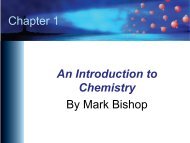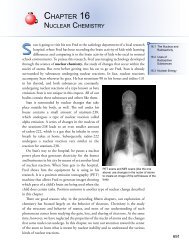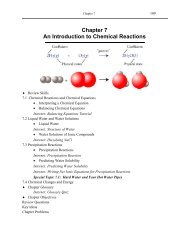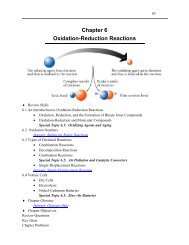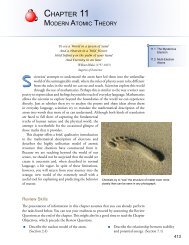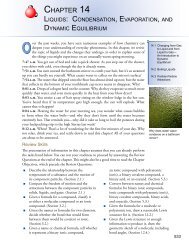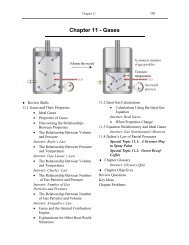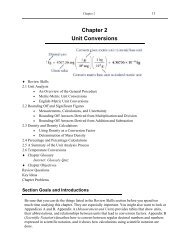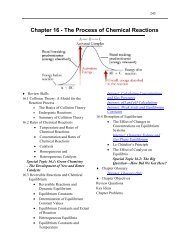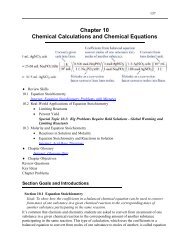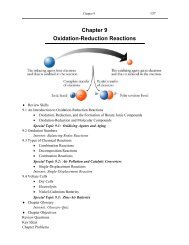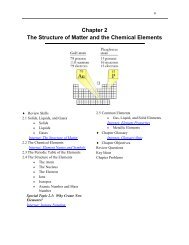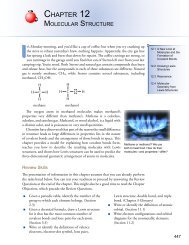Chapter 10 - An Introduction to Chemistry: Chemical Calculations ...
Chapter 10 - An Introduction to Chemistry: Chemical Calculations ...
Chapter 10 - An Introduction to Chemistry: Chemical Calculations ...
Create successful ePaper yourself
Turn your PDF publications into a flip-book with our unique Google optimized e-Paper software.
<strong>10</strong>.2 Real-World Applications of Equation S<strong>to</strong>ichiometry 379<br />
Now let’s apply what we have learned from the bicycle example <strong>to</strong> a calculation that<br />
deals with a chemical reaction. Electronic grade (EG) silicon used in the electronics<br />
industry is a purified form of metallurgical grade silicon, which is made from the<br />
reaction of silica, SiO 2 , with carbon in the form of coke at 2000 °C. (Silica is found in<br />
nature as quartz or quartz sand.)<br />
SiO 2 (s) + 2C(s)<br />
2000 °C<br />
Si(l ) + 2CO(g)<br />
If <strong>10</strong>00 moles of carbon are heated with 550 moles of silica, what is the maximum<br />
number of moles of metallurgical grade silicon, Si, that can be formed? This example<br />
is similar <strong>to</strong> the bicycle example. We need two times as many wheels as frames <strong>to</strong> build<br />
bicycles, and <strong>to</strong> get a complete reaction of silicon dioxide and carbon, we need two<br />
a<strong>to</strong>ms (or moles of a<strong>to</strong>ms) of carbon for every formula unit (or mole of formula units)<br />
of silicon dioxide.<br />
1 frame + 2 wheels → 1 bicycle<br />
SiO 2 (s) + 2C(s)<br />
→ Si(l ) + 2CO(g)<br />
In the reaction between carbon and silicon dioxide, we can assume that one of the<br />
reactants is in excess and the other is limiting, but we do not yet know which is which.<br />
With the bicycle example, we discovered which component was limiting (and also the<br />
maximum number of bicycles that can be made) by calculating the maximum number<br />
of bicycles we could make from each component. The component that could make the<br />
fewer bicycles was limiting and that number of bicycles was the maximum number of<br />
bicycles that could be made.<br />
For our reaction between carbon and silicon dioxide, we can determine which<br />
reactant is the limiting reactant by first calculating the maximum amount of silicon<br />
that can be formed from the given amount of each reactant. The reactant that forms<br />
the least product will run out first and limit the amount of product that can form. The<br />
coefficients in the balanced equation provide us with conversion fac<strong>to</strong>rs <strong>to</strong> convert<br />
from moles of reactants <strong>to</strong> moles of products.<br />
? mol Si = <strong>10</strong>00 mol C<br />
? mol Si = 550 mol SiO 2<br />
1 mol Si<br />
2 mol C<br />
1 mol Si<br />
1 mol SiO 2<br />
= 500 mol Si<br />
= 550 mol Si<br />
The carbon will be used up after 500 moles of silicon have been formed. The silicon<br />
dioxide would not be used up until 550 moles of silicon were formed. Because the<br />
carbon produces the least silicon, it runs out first and limits the amount of product that<br />
can form. Therefore, the carbon is the limiting reactant, and the maximum amount of<br />
product that can form is 500 moles Si.<br />
Now let’s work a problem that is similar but deals with masses of reactants and<br />
products rather than moles. If 16.491 g of carbon are heated with 32.654 g of silica,<br />
what is the maximum mass of metallurgical grade silicon, Si, that can be formed?



